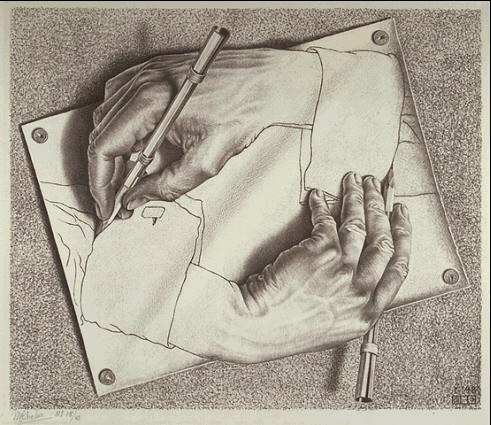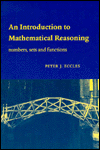 |
MAT 200 |
 |
MAT 200 |
This course offers an introduction to mathematical reasoning and proofs. It is intended as a bridge between the loose, heuristic approach often used to teach elementary calculus, and the precise, formal style needed for upper-division mathematics courses.
 Textbook:
Textbook:
An Introduction to Mathematical Reasoning:
Numbers, Sets, and Functions,
by Peter J. Eccles,
Cambridge University Press, 1997.
The text should be available at the campus bookstore, Stony Books, and other local bookstores. You could also quickly obtain a copy from Amazon, Barnes & Noble, or some other on-line book-seller. Most such merchants offer overnight shipping for an additional charge.
Some students have asked me to suggest a supplementary book to read alongside the assigned text. I frankly think that using a second book would not be a good idea for most of you, and would generally urge you to just focus on studying your textbook. Still, different students have different learning styles, and another book might be genuinely helpful in some limited circumstances. For example, students who have developed a mental block regarding the assigned text might possibly find The Nuts and Bolts of Proofs, by Antonella Cupallari, to be somewhat helpful, as it is shorter and less sophisticated than Eccles. On the other hand, How to Prove It, by Daniel Velleman, uses more symbolic logic than our textbook, and students of a certain mind-set could find this appealing.
 Some weeks, you will be assigned readings from the Mathematics Department's
Geometry Notes,
rather than from the textbook. These notes are available from this web-site
as a free download, in PDF format. To read them, however, you
will need a PDF viewer. In the unlikely event that your computer
does not already have such software installed,
Adobe Reader may be downloaded, free of charge,
by clicking the icon at left.
Some weeks, you will be assigned readings from the Mathematics Department's
Geometry Notes,
rather than from the textbook. These notes are available from this web-site
as a free download, in PDF format. To read them, however, you
will need a PDF viewer. In the unlikely event that your computer
does not already have such software installed,
Adobe Reader may be downloaded, free of charge,
by clicking the icon at left.
Two different kinds of homework problems will be assigned in this course.
Ungraded problems are not to be turned in, but you are expected to solve them carefully, in great detail; failure to so may result in an inability to understand the course material. Answers to these problems are usually contained in the back of your textbook. Don't peak, though! If you simply look up the answer before seriously trying to find the solution, the only person you will be cheating is yourself.
Homework sets, by contrast, will be turned in --- usually on Tuesdays. Your performance on these assignments will significantly affect your grade in the course. These assignments may be found by clicking on the hyper-link below. Keep in mind that these assignments are subject to revision until the previous Thursday. You are therefore encouraged to frequently check the relevant web-page for changes. Refreshing your browser while doing so will ensure that you are really looking at the latest version.
Late homework will not be accepted. However, grades for homework assignments may be dropped in cases of documented medical problems or similar diffculties.| Midterm I | Thursday, Feb 28 | 11:20 am-12:40 pm |
| Midterm II | Tuesday, April 8 | 11:20 am-12:40 pm |
| Final Exam | Tuesday, May 20 | 11:00 am-1:30 pm |
No make-ups will be given for missed midterms. However, if you miss an exam because of convincingly documented circumstances beyond your control, then, at the professor's discretion, the relevant score may be `dropped' in computing your course grade.
A grade of Incomplete will be granted only if documented circumstances beyond your control prevent you from taking the final exam.
Grading: Your course grade will be based on your
examinations and homework,
weighted as follows:
| Midterm I | 25% |
| Midterm II | 25% |
| Final Exam | 35% |
| Homework | 15% |
The prerequisites for this course are:
Professor LeBrun's office is Math Tower 3-108. His office hours are TuTh 10:10--11:10.
To make an appointment outside of regular office hours, or to e-mail Prof. LeBrun for any other reason,The grader for the course is . His office hours are Tuesdays 1--2 in the Math Learning Center, and Tuesdays 2--4 in Math Tower 3-103.
You are encouraged to seek help with your homework by visiting the Math Learning Center. Any of the MLC's grad students in pure math should be able to help you. However, be sure to explicitly ask for a graduate student in pure mathematics, since the MLC also employs many undergraduate tutors and graduate students from other departments who may not be well qualified to help you with this course.
Stony Brook University expects students to maintain standards of personal integrity that are in harmony with the educational goals of the institution; to observe national, state, and local laws as well as University regulations; and to respect the rights, privileges, and property of other people. Faculty must notify the Office of Judicial Affairs of any disruptive behavior that interferes with their ability to teach, compromises the safety of the learning environment, or inhibits students' ability to learn.
DSS advisory. If you have a physical, psychiatric, medical, or learning disability that may affect your ability to carry out the assigned course work, please contact the office of Disabled Student Services (DSS), Humanities Building, room 133, telephone 632-6748/TDD. DSS will review your concerns and determine what accommodations may be necessary and appropriate. All information regarding any disability will be treated as strictly confidential.
Students who might require special evacuation procedures in the event of an emergency are urged to discuss their needs with both the instructor and DSS. For important related information, click here.